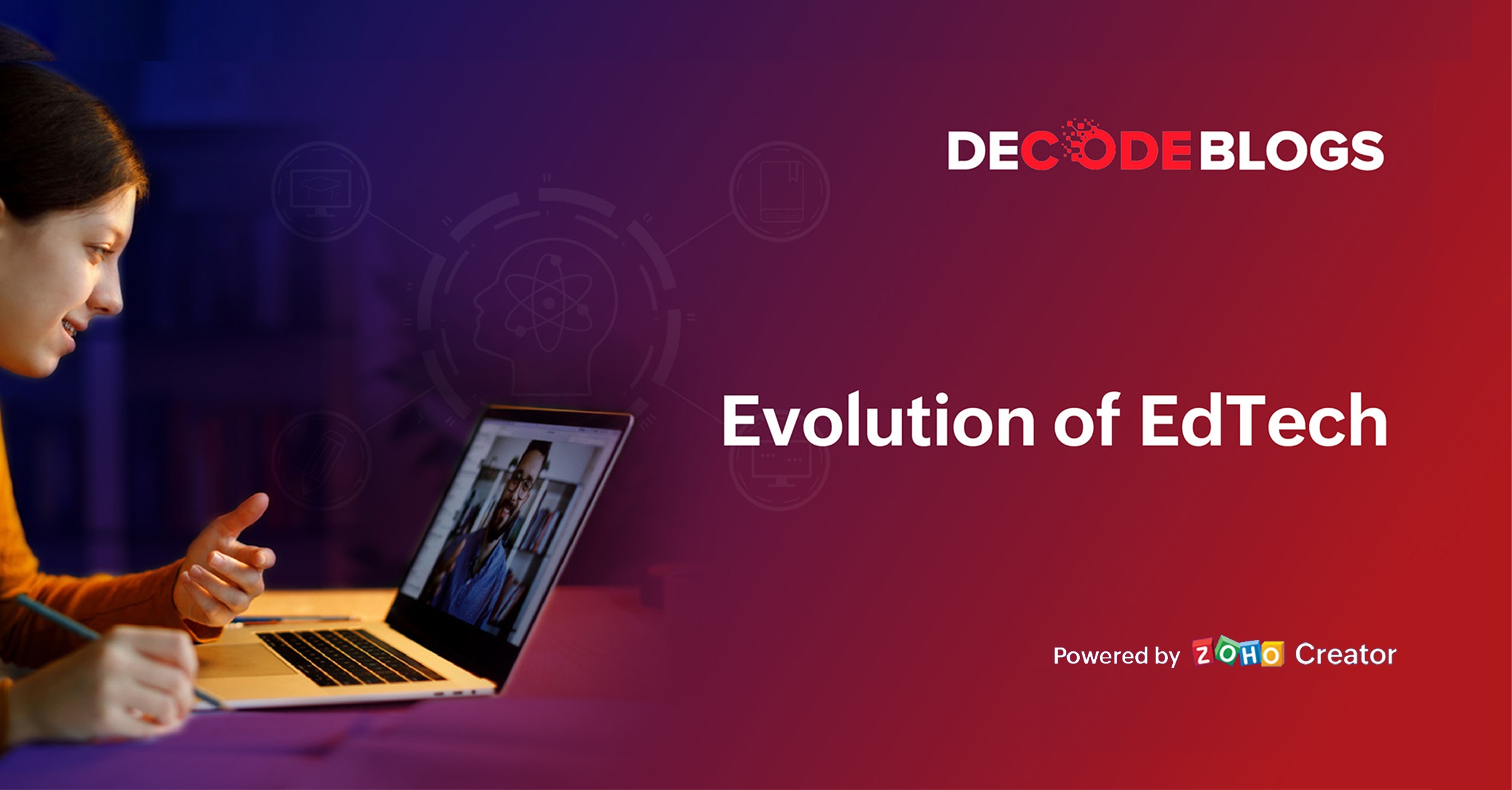- HOME
- Know Your Tech
- Remote education: Reimagining the role of EdTech
Remote education: Reimagining the role of EdTech
- Last Updated : April 20, 2023
- 1.0K Views
- 7 Min Read

The COVID-19 pandemic has impacted industries around the world, some far more than others. Food, retail, supply chains, entertainment, and airlines were among the most impacted industries during these unprecedented times, which has prompted a digital revolution to ensure uninterrupted operation. It's believed that this digital adoption will remain over the long-term, and many industries are increasingly open and receptive to the notion of functioning largely, or fully, digitally.
The education sector is one such industry that has been compelled to embrace a digital transition. Moving from physical to virtual classrooms for regular courses was unthinkable just a couple years ago. However, in order to ensure continuous education, schools and colleges all around the world have now gotten accustomed to virtual classrooms.
Keeping up with virtual classes has become imperative, even though the shift to digital learning was quite difficult, owing to a variety of factors such as accessibility and affordability. Although there are downsides to online learning, the benefits generally outweigh the drawbacks. Remote education is flexible and safe, especially in times like these—and its rapid adoption poses the pivotal question of whether the future of education relies on EdTech.
Education in the pre-COVID era
Before the pandemic, apart from distance education courses, online programs were not widely utilized as a preferred mode of learning. The regular mode of learning was favored owing to its efficiency. When COVID-19 hit, the entire world came to a halt, compelling educational institutions to transition from face-to-face to online learning. This forced institutions to explore the opportunities provided by online education.
Challenges in transitioning to remote education
Since educational institutions were largely closed, digital transformation was essential to guarantee continuous learning for all students—but the switch from physical to online classrooms was not seamless for everyone. This transition posed many obstacles, ranging from technology to pedagogy to socioeconomic aspects. Let's look at some of of the difficulties faced by the industry during the pandemic:
Technology: Since online learning is entirely reliant on gadgets and the internet, teachers and students with inadequate internet connections find it difficult to access online learning. The reliance of online learning on technological equipment, as well as the availability of such equipment, has posed a significant problem for institutions, teachers, and students.
Socioeconomic factors: Students in remote regions were disproportionately impacted, because they couldn't afford or access stable internet connections to support their learning. Hence, students from low socioeconomic backgrounds found it difficult to transition to a tech-heavy learning environment.
Supervision: Another significant challenge is regulating students' actions during online classes. Maintaining student attention and coordination is essential in a virtual classroom setting. Considering how difficult it is to get children, especially younger ones, to stay attentive in person, expecting them to stay on task during online sessions is an even greater ask.
Assessments: Exams are feasible in online learning, but maintaining decorum and limiting cheating is challenging in a virtual environment. Add this to the fact that it's difficult to ensure the same learning experiences and opportunities through online learning sessions, which complicates the evaluation process even more.
Tech Table Talks, our virtual round table series, recently tackled this critical issue, addressing the question of whether the future of education relies on EdTech. Raju Vegesna (Zoho Chief Evangelist), Simon Whitebridge (consultant, Royal College of Surgeons in Ireland - Bahrain), and Pratik Rohra (Zoho Creator, product marketer), were the industry experts who participated in our round table discussion. Continue reading to learn more from our experts regarding COVID-19 and remote education, as well as the emergence of EdTech.
What is EdTech?
The idea of incorporating IT resources into the classroom to produce a more engaging, inclusive, and personalized learning experience is known as education technology, or EdTech. The promise of scalable, customized learning has played a significant role in the rise of EdTech. It has revolutionized the education sector and will continue to play a significant role in education in the future.
Zoho's vision to revolutionize the education sector
Raju - We want to offer the tools and technologies needed for the industry. Tools are purely enablers, and I would consider them successful if they simply get out of the way. In other words, if students and teachers get things done efficiently, without worrying what tools and technology to use, I'd consider it a success. Hence, the end goal at Zoho is to offer the right tools—focusing on the task at hand, with tools not being the focus, but the key.
Keeping up with current trends
Going from a regimented in-person school-day to a fully online one can be challenging to adjust to. It's not just about transitioning to online learning, but also about how it is structured. From conducting classes, exams, and assignments to monitoring student attendance, it's imperative to have the right tools and technology.
Simon - Technology was previously considered an enabler, but more recently it has become a critical part of education. Globally, we've moved to distance learning completely. We record lectures. The other thing which has become critical is examination. We have to move to technology-driven examination. We certainly have faced issues—clearly, proctoring is a crucial part of the examination process, and it has become one of the challenges to ensure that exams are taken in a fair way by students.
Raju - EdTech itself is fairly broad. Technology in the context of education can be used on the administration side of things. There is a toolkit needed for students and teachers and tools needed to communicate with parents. What technology we use for what context is the key, and communicating is the key, playing a prominent role in remote learning. The education technology toolkit has expanded based on the current dimension in the world. Productivity, collaboration, and communication tools, besides other tools, like Creator, come together to become the enabler for the market.
COVID-19 and remote education
Using the right tools and technology is vital for remote education, as it makes or breaks the entire learning experience for both students and teachers. To make remote learning a success, additional resources must be spent in digital, pedagogical, and other areas. Access to high-quality digital infrastructure and equipment, including tools and expertise to ensure digital safety during online learning, is a critical component.
Simon - Recent events have changed the face of education. Before COVID, we would have never dreamt about online or recorded sessions because we didn't consider it as worthy way of teaching. But now we're considering online training as part of our curriculum.
Raju - There are two aspects of tools—tools in the context of in-person education and tools in the context of remote education. Remote education brings in new challenges, and part of it is communication. Various aspects, like interaction between students, will be lost. Certainly there are other intangible things, and there's no way to replicate them in the online world. Tools need to evolve to address these challenges. If tools are trying to replicate these conditions, we may not see any benefits and we may need to find a new model. But there are several advantages and disadvantages to remote education. Tools can solve all these problems, and it's important for tools to evolve in this new model. There are psychological aspects, like teachers being extra communicative with the students. In a remote world, parents play an increasingly important role.
Remote education is:
Flexible
Affordability
Can be attended from anywhere
Engaging
Customizable
Rise of EdTech
EdTech has recently emerged as a viable alternative to traditional modes of education. The ease of access, abundance of options, and flexibility that online education provides enable students and professionals to immediately take advantage of the ability to continue their education and upskill themselves. Modern education technology, when combined with convenience and collaboration, has resulted in a more refined knowledge transfer technique.
During the pandemic, EdTech firms noticed an increase in the number of students enrolling, as more and more professionals were willing to experiment with online learning, given the work-from-home setup. The trend is expected to continue, even in the post-pandemic world, as there are so many untapped opportunities. In the coming years, many educational institutions are expected to adopt a hybrid approach to education, both in and out of the classroom.
Future of EdTech
Remote education has been in the limelight as of late, and one of the growing concerns has been how educational institutions secure their students' and teachers' personal data and privacy. The collection and potential use of students' personal information, as well as the usage of services or platforms that are not suited for children, are among the privacy issues that come with online learning technology. Some educational institutions that are unfamiliar with EdTech or online learning may choose less privacy-friendly technologies and platforms, as a result of the sudden shift to remote education.
Although there are many privacy concerns, online learning can be effective with the right tools and technology. It's paramount to choose a tool that works best for both the students and the teachers in the long run. According to the poll taken during our round table, most attendees said they prefer online learning, even after things return to normal. Virtual classrooms are here to stay, with the global EdTech market expected to rise exponentially by 2027.
Raju - When forced to create an account by giving the information of a student, and not considering the privacy implications as a parent, it's damning. Education institutions need to take privacy more seriously. At Zoho, data privacy is our top priority.
Over the last few years, EdTech has evolved from live lectures to online laboratories to online exams. As such, the cloud, AI, and machine learning will play a critical role in the future of EdTech, as the capacity of these technologies to automate even the most fundamental functions, like grading, communication, feedback, assessment, and more, to improve the user experience.
Low-code platforms, like Zoho Creator, allow you to build your own educational management app to solve many of the challenges we've talked about in this article. Every stakeholder can benefit from end-to-end school and higher education systems. From administration to grading, you can manage everything in one place, with Zoho Creator.
 Aishwarya
AishwaryaAishwarya is a content marketer at Zoho. Apart from creating content, she loves to read and watch sci-fi and crime thrillers, travel, and basically can't survive without coffee.



